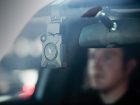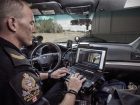
Features
Medicine Hat Police Service pilots body worn technology for better data management
Body worn technology in Canada today isn’t about police services playing Big Brother to their officers. It also isn’t about recording every little interaction with the public.
November 15, 2017 By Renée Francoeur

It is about balancing privacy with operations and the efficient collection of evidence in this highly interconnected 21st century environment, says Insp. Joe West with Medicine Hat Police Service’s operational service division.
The southern Alberta service began a six-month body worn technology pilot with Axon Public Safety Canada Inc. this September. It features six officers testing out Axon Body 2 cameras as well as two in-car cameras, Axon Fleet, and the company’s Canadian Cloud-based digital evidence management solution, Evidence.com. MHPS is the first police force in Canada to use Axon Fleet, launched last year, in the field.
“The purpose is to see how much value there is in dash cam and body cam versus the body cam alone,” West says.
Other goals of the pilot, which is free of charge for the full duration, include:
• Enhancing the collection of evidence,
• Enhancing transparency, public trust and confidence;
• Enhancing officer accountability and professionalism;
• Protecting officers from unfounded allegations of misconduct; and
• De-escalating volatile situations.
While body worn cameras (BWCs) remain a hotly debated topic worldwide — and a technology Canada as a whole has been slower to test out — MHPS Chief Andy McGrogan told the press he believes “we need to continue to be innovative in the use of technology best practices,” to help shape the future of policing’s information management strategy.
The ground rules
About a year ago, MHPS conducted an in-house survey with nearly 90 per cent of officers responding, according to West. Of those, about 83 per cent were in favour of body worn cameras.
“That gave us an idea of how the membership felt about it, so they seem to be completely on board,” he says. “We have had what we believe to be unfounded accusations against officers in the past and I know I’ve heard conversations around the building along the lines of, ‘Well, if we’d have just had body cams, this wouldn’t even be an issue.’ Anecdotally, I think we could see a reduction in complaints [against officers]. And it goes both ways; it’s basic human nature that when you know you’re on video, you tend to be extra conscious of your conduct.”
West says MHPS analyzed a number of body worn camera (BWC) policies already in place among forces in Canada, including Calgary Police Service, which is currently evaluating vendor proposals for a new BWC program — after filing a $586,000 statement of claim due to technical issues against the winning bidder in a 2014 request for proposal to purchase 1,100 BWCs.
MHPS rolled out its own take on a BWC policy for officer training purposes before securing the pilot. This policy was also based on findings from the 2015 guidelines published by the Office of the Privacy Commissioner of Canada, which included recommendations such as implementing a system to ensure retention policies are adhered to and minimizing, to the extent possible, the recording of innocent bystanders, among others.
“The big thing is: should cameras be on all the time?” West notes. “So our policy gives a lot of discretion to officers. There are some ground rules — if you’re actively investigating something or if you’re on your way to a call for service, for example, [the BWC] should be turned on. But it’s not to be on for the whole shift.”
He says one example where the new tech proved especially useful was during a recent mental health incident and arrest.
“You can see through the video that the officers did a great job of trying to de-escalate and forming the grounds for the arrest. They made the arrest. There was a physical altercation and they brought it back and said, ‘You have to see this,’” West says. “I think they were quite satisfied to see some good work captured and that the video showed them doing it by the book — it was a use-of-force transaction and everything turned out OK.”
When it comes to resist-arrest calls and similar situations, “we’re hoping that the proof is in the pudding, so to speak, and [BWCs] will speed those types of convictions or guilty pleas up,” West says.
Additionally, with just three weeks under its belt, the pilot has already been sparking positive talk among Crown prosecutors, he adds, who were remarking on how the videos are giving them better insight and providing them with a 3D context to police work on the ground.
A Canadian lens
Over 314,200 cameras have been purchased globally from Axon and can be found in 38 major city police departments in North America, says Vishal Dhir, Axon’s managing director for Canada & Latin America, but the company only launched its Cloud solution in Canada in 2015. Furthermore, Canadian pilots with Axon products just started up in 2016.
A municipal bylaw agency in Russell Township, located southeast of Ottawa, was one of the first to test out Axon’s BWCs in the Great White North.
“They had positive results and actually had an officer accused of mistreatment, but because they had the footage on the camera, they were able to show what really happened and it was dealt with in 15 minutes rather than moving into a full investigation, which can be costly to the agency,” Dhir says.
Free field-testing, he says, allow agencies to judge the value of BWCs on their own.
“We are so close to the U.S. that a lot of the initial conversations I had with chiefs and agencies last year were about transparency and accountability, because those were the messages we were hearing from the States,” Dhir adds. “Those aren’t the primary issues we’re dealing with in Canadian policing. When you look at the U.K. model or the one in Australia, we see different use cases for body worn and those are what Canadian agencies need to be looking at.”
He goes on to cite Australia’s Queensland Police Service, which has been working with the Crown for an accelerated evidence program in regards to domestic partner violence using video captured in the field and Evidence.com.
Interviews recorded in the field, rather than back at the station, mean more raw emotion, Dhir continues.
“From doing this, [Queensland Police] found they were experiencing a 60-70 per cent decrease in summary meetings because there were so many early pleas of guilt,” he says. “And when they started advertising what they were doing, more people were calling in because the problem was actually being dealt with much faster.”
Power & time
“Battery life” is often whispered about as a BWC flaw, but that is old news, Dhir insists, pointing to officers in Fredericton, N.B., whose shortest BWC battery life was over 12 hours when one officer was pulling overtime with the Axon Body 2.
“Even then, it didn’t turn off — the battery indicator let the user know it needed to be charged,” Dhir explains.
“A customer in Nunavut is using our first generation camera and they still get 10 hours plus video and their shifts are eight hours long. Montreal piloted with us last year and they were routinely getting 12 hours plus.”
Concern over how much time is needed to process the data — bringing it back to the station, uploading and then tagging the information — has also been expressed. And it’s been addressed, according to Dhir.
“We’ve paired mobile devices with our body cams so officers can tag video in their downtime while in their cars, rather than waiting to upload,” Dhir says, speaking to Axon’s mobile app, Axon View. “All of the metadata is uploaded once you go back to the station and dock the camera — none of the information stays on the cellphone.”
Other features include: redactions that are built right into the system and built-in workflows to allow for transcription for chain of custody requirements.
In fact, Axon body worn footage has a “forensic chain of custody,” according to Dhir, which means it creates a unique ID and a Sha-2 hash on each video uploaded to Evidence.com, “so you always know it’s the original.” It also pinpoints the IP address to who opens and accesses that information and captures every interaction with that piece of evidence in the audit trail, Dhir says, never altering the original (you’re always working with a derivative).
“These are the types of things Cloud-based systems allow you to do because you have the computing power to do it, but you also have the auditability, which is far more secure and accurate than the paper chain of custody policing has in place today.”
Price tags
A lot of the BWC cost estimates from former studies were based on on-premise solutions only, Dhir notes. They’re accurate if you have such a solution because they account for building out your own data centre and infrastructure to store it all.
With respect to BWCs and using Cloud vs. “on-premise” solutions, Axon says it has “routinely found the cost to be at least 70 per cent less of the estimated cost of on-premise.”
The amount of storage high-quality video requires has always been a stumbling block, according to West.
“But with Cloud-based storage, we don’t expect our costs to be any higher than some of our costs now with our servers,” West says. “The video processing and packaging for Crown is really at your fingertips. We’re convinced it’s secure and we’re confident about it.”
(Data is protected all the time, even when the camera is “at rest,” Axon notes.)
The hardware costs are around $499 per camera but as for final numbers, West says the service will look at how much data is collected and processed, how many times it’s deposited and retrieved, etc. to determine the overall cost of implementing a permanent BWC program.
“We’re approaching it with the knowledge that it’s going to be much more cost-effective than having to come up with some sort of process on our own and store it here on site,” West says.
In-car revisited
Similar to BWCs, Axon wanted to up the efficiency of in-car cameras with the 2016 launch of its Axon Fleet product.
“We wanted to change how in-car is thought of,” Dhir says. “They’re really expensive for one and take a lot of maintenance.”
He explains that, while it’s not a large kind of camera — ringing with all the bells and whistles — its simplicity means good field-of-view and easy management — from tagging to offloading.
“Typically a police car has to go out for a few days to have an in-car camera installed. We can do it in about an hour because the setup is simplified and all Cloud connected.”
Meanwhile MHPS hasn’t had in-car cameras since the days when the VCR was locked in the trunk.
“We’re looking at this as part of the whole video program but I think we’ll capture more with the body cams,” West says. “I’ve had more feedback about that from the officers — not so much from the in-cars.”
BWC down the road
Currently, all the video from MHPS’s interview rooms and cells are burnt to disk, according to West.
“I see that all going to the Cloud in the future, maybe five years from now,” West speculates.
Cloud technology is helping the efficiency side of policing, Dhir deduces. “We have to find better ways to allocate police time, especially with budgets being so restricted.”
In a Canadian policing context, major cities are starting to look at BWC for better evidence gathering and faster trials and investigations, he adds.
“But in my opinion, it’s more about the backend of systems because one of the challenges in policing right now is information management — moving from an infrastructure world to an information world will be a big transformation.”
As for West, he advises those interested in BWC programs do their research.
“It was critical that we came up with a policy. It was critical that we closely examined privacy issues, looking hard at the privacy commissioner’s guidelines and making sure the Crown persecutors were on board,” he says. “Those are the key things in developing the program.
Print this page



